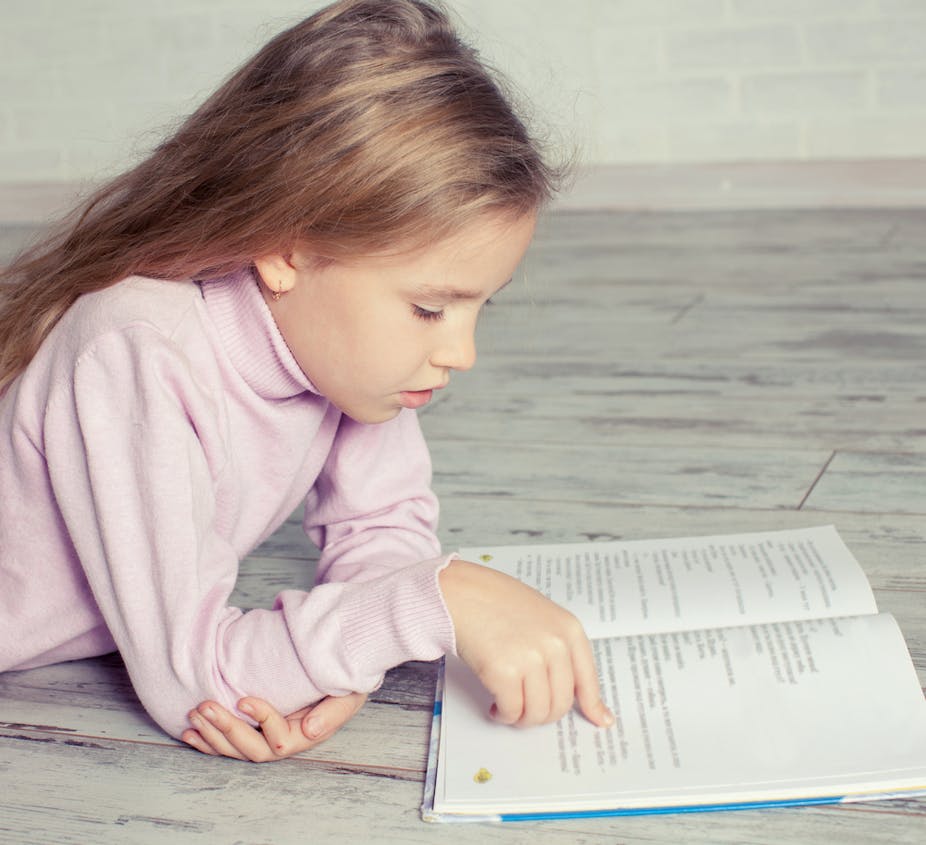Reading Recovery has been a popular remedial reading program in Australian schools for many years, but there has been some recent discussion questioning how effective it really is.
The last time Australian children’s reading achievement was benchmarked against that of other countries in 2011, it was the lowest in the English-speaking world. Given the vital importance of literacy it is important we ask ourselves why.
Reading as a ‘natural’ process
Mainstream early literacy teaching and Reading Recovery are both still grounded in the idea that reading is a natural process, and that children learn merely via exposure to print. However, we now know this is not the case. Reading is a complex, learnt skill.
A small number of children do appear to teach themselves to read. Many others are taught before they start school by a family member or preschool teacher.
However, learning the complex, opaque English writing system takes most children several years. Many children simply can’t learn unless they are taught to discern sounds in words and represent them with letters just one or two at a time, and given lots of practice with each pattern.
A wait-to-fail system
After a year of trying, many children still haven’t learnt to read. Children with speech-language and cognitive difficulties fare particularly poorly. Some children who are good at memorising words visually seem to be doing okay at first, but unless they learn to sound out, they are soon falling behind.
Reading Recovery originated in New Zealand as a way to help struggling readers in their second year of schooling. However, its content does not specifically target the main areas in which most beginners struggle – speech sounds and their spellings, or phonics.
Each Reading Recovery session involves reading familiar and unfamiliar books, with encouragement to guess from pictures, first letters and context. Students also assemble cut-up sentences, write personal sentences, and do a single phonics activity involving building words with movable letters.
Reading Recovery is an intensive, one-to-one program delivered half an hour a day for 12-20 weeks by specialist teachers. It has been in use in New Zealand now for 30 years, so you’d expect Kiwis to be doing well. However, New Zealand’s results were barely better than Australia’s in the recent international benchmarking exercise.
Reading Recovery is a proprietary program, meaning it can only be accessed by teachers trained and registered to be Reading Recovery teachers. This means it can only be researched with the consent and co-operation of its publisher, using teachers who have already been instilled over months of training with the belief that it is of benefit.
Research exists showing it has a positive effect compared to doing nothing or a mixture of interventions of variable quality. But most things teachers do have a positive effect, so that’s no surprise.
More interesting research would compare Reading Recovery with programs we know are consistent with the reading science, and that we know from well-conducted experiments have significant positive effects. I am not aware of any such research.
Many long-term studies of reading achievement have shown that children who don’t get off to a good start with literacy tend not to catch up. Like a rocket poorly lined up on the launching pad, they can end up very far from where they are meant to be.
Teaching needs met from Day One
Louisa Moats, the academic whose criticisms of Reading Recovery attracted recent media attention, is one of the leading US proponents of more evidence-based practice in literacy education. In particular, she urges that teachers be taught more about language, so that they are equipped to teach literacy in a more successful and evidence-based way.
Moats points out that reading is one of the most studied aspects of human behaviour, and we know a great deal about it. Yet the way we teach it typically doesn’t reflect the scientific consensus on what works best.
We vaccinate all children against deadly diseases, regardless of whether they are susceptible or likely to be exposed to them. The risks of not doing so are simply too great.
Likewise, we should be giving all children explicit and well-sequenced instruction about speech sounds and spelling patterns, integrated with work on vocabulary, comprehension and fluency, right from when they start school.
Practices such as guessing from context, pictures and first letters (known as “searchlights” or “multiple-cues” teaching) should be eliminated as having no basis in reading science.
Choosing an effective remedial program can be tricky when vulnerable parents and concerned teachers look to commercial resources. However, teachers and parents should be guided by the principles of effective reading instruction outlined in the National Inquiry into the Teaching of Literacy and current research findings that highlight the importance of alphabetic approaches that systematically and explicitly teach phonological awareness and phonics to mastery.
Programs that meet these criteria include: MiniLit and MultiLit, Little Learners Love Literacy, Get Reading Right, Jolly Phonics, Sounds Write, Write to Read, Read Write Inc and Letters and Sounds.
This would line all children up correctly on the launching pad, ready for a successful learning trajectory, regardless of linguistic or cognitive skills, or family circumstances.
During her recent National Tour, Moats warned Australians about the gap between research and practice in literacy education and urged us to replace our current wait-to-fail system with one that ensures maximum success for all learners. In our increasingly complex, print-based society, it is simply unacceptable to do otherwise.

